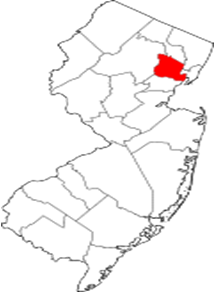Essex County, NJ

From Wikipedia, the free encyclopedia
Historic Essex County Hall of Records
Essex County is a county located in the northeastern part of the U.S. state of New Jersey. As of the United States 2010 Census, the population was 783,969, ranking it third in the state after Bergen County and Middlesex County; Essex County’s population has declined from 786,147 as of the bureau’s 2006 population estimate, and from 793,633 as of the 2000 census. Its county seat is Newark. It is part of the New York Metropolitan Area.
The county is named after Essex, a county in east England.
Essex County is the second most densely populated county in the state after Hudson County, and has the third largest total population after Bergen County and Middlesex County. Newark, with a population density of 11,400 people/square mile, is the largest municipality in the county both in terms of area (24.14 square miles) and population (280,000). Meanwhile, Caldwell is the smallest in terms of land area (1.2 square miles) and Essex Fells has the smallest population (2,071); nevertheless, even these small towns have population densities (6,396 people/square mile and 1,534 people/square mile, respectively) that rival many big cities, and are well above the state’s average, which in turn is the highest in the nation.
Like many of the counties of Northern New Jersey near New York City which tend to have sharp divides between relatively rich suburban neighborhoods and less wealthy, more densely-populated cities nearby the eastern region of Essex County tends to be poorer and more urbanized, while the western parts tend to be more affluent and suburban.
Eastern Essex This wide area has significant pockets of areas that qualify as inner-city: high building density, high poverty and high crime rates and underperforming school systems. Within this general area however are many stable, mixed and middle-income areas of diverse populations. For example, north and west sides of Newark have well-kept suburban areas such as Vailsburg and Forest Hill, Newark, New Jersey. The east side of Newark is the Ironbound, a thriving Brazilian and Portuguese community. East Orange has the Presidential Estate neighborhood full of large one family homes. Belleville and Bloomfield are old Italian cities that, in spite of retaining a core Italian-American population, now have many immigrants from Latin America and Asia. According to Epodunk, as of 2009, Nutley was 36% Italian.
Beginning at about the turn of the century, this region led the state in the rebuilding and rehab of its housing stock. In the 2000s, Newark led the state in the issuance of building permits. Many reasons were cited: city-wide incentives to encourage construction development, an improving local economy, the rising demand of low-cost housing so close to Manhattan. Newark has since then become one of the fastest growing cities in the entire Northeast. And reported a gain in median income and drop in poverty rate. This is a welcome turnaround to the deterioration and abandonment, experienced in the post-riot 70’s, 80’s and early part of the 90s.
Crime in this part of the county has traditionally been among the highest in the state and the country as well, but recently has also seen significant declines, mirroring its large neighbor to the east, New York City. By 2006, crime in Newark had fallen 60% over 10 years to its lowest levels in 40 years. Neighboring East Orange has seen crime fall more recently, dropping 50% in the three years (2005 to 2007). While homicide rates have fallen in Newark and East Orange in recent years, homicide rates in Newark, Irvington, East Orange, and Orange remain stubbornly high. In 2008, Newark had 67 homicides, down from 105 in 2007 and the record of 161 murders set in 1981.
In contrast, Western Essex tends to be more suburban and affluent. Within this region are some of the most diverse and racially integrated municipalities in the state and nation, including Montclair, and Maplewood. As well, many neighborhoods are well-known magnets for New Yorkers such as Glen Ridge, Montclair, Verona and the Oranges. The communities of Livingston, Roseland, South Orange, Millburn, North Caldwell, and Essex Fells are some of the wealthiest towns in America. Short Hills, South Orange, and Livingston are regionally well-known as affluent Jewish-American suburbs. Short Hills has a popular upscale shopping mall, the Short Hills Mall.
As the poorest place in the county, Newark has a median household income of $26,913 and a per capita income of $13,009; at the other extreme, Essex Fells, one of the wealthier places in the county and the 4th wealthiest municipality in the state, has a median household income of $148,173 and a per capita income of $77,434. Newark and Essex Fells are only ten miles apart.
While many residents commute to New York City, Organon International, Anheuser-Busch, Automatic Data Processing, Inc., CIT Group, Hoffmann-LaRoche, Grainger, Dun & Bradstreet and Prudential have large facilities in Essex County or are headquartered there, and there are numerous factories and large office parks scattered throughout.
Essex County was one of the first counties in America to become fully urbanized[citation needed] and was the first county in the country to create a county park system (Essex County Park System, New Jersey), to ensure that it did not lose all its land to development.
The various towns of the county, especially Newark, the Oranges, and the Caldwells can be seen in every episode of the HBO mob drama The Sopranos, which is set in North Caldwell.
The county is also home to Newark Liberty International Airport, Essex County Airport, and Port Newark-Elizabeth Marine Terminal.


